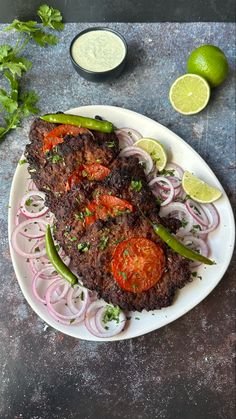

The Irresistible Allure of Kababs
Kababs, a dish of global fame, are synonymous with flavorful and succulent bites of grilled perfection. From street food stalls to gourmet restaurants, kababs have cemented their place in the hearts of food lovers worldwide. Let’s delve into the origins, types, and preparation secrets of this timeless delicacy.
A Glimpse into the History of Kababs
The word “kabab” is believed to have originated from the Arabic word “kabāb,” meaning “to roast.” The origins of kababs can be traced back to the Middle East and Central Asia, where they were first prepared as a means of cooking meat over open flames. Traders, travelers, and invaders brought kababs to the Indian subcontinent, where they evolved into diverse regional variants.
Types of Kababs
Kababs come in countless variations, each offering a unique taste and texture. Here are some of the most popular types:
- Seekh Kabab: Made with minced meat mixed with spices and shaped onto skewers, seekh kababs are grilled to perfection for a smoky flavor.
- Shami Kabab: A soft and flavorful kabab made with minced meat, lentils, and spices, Shami kababs are pan-fried and often served as a starter.
- Galouti Kabab: Originating from Lucknow, this melt-in-your-mouth delicacy is made with finely minced meat and a blend of aromatic spices.
- Chapli Kabab: A specialty from the Pashtun regions, chapli kababs are flat, spicy, and often cooked with tomatoes and pomegranate seeds.
- Vegetarian Kabab: For vegetarians, kababs made from paneer, vegetables, or soya chunks offer a delightful alternative.
- Doner Kabab: A Turkish delight, these kababs are made with sliced meat cooked on a vertical rotisserie, often served in wraps or sandwiches.
The Art of Kabab Making
The secret to perfect kababs lies in the quality of ingredients and the cooking technique. Here are some tips to master the art of kabab making:
- Choose the Right Meat: Tender cuts of meat or finely minced meat work best for kababs.
- Marinate Generously: Marination is key to infusing flavors and tenderizing the meat. Use yogurt, spices, and lemon juice for best results.
- Blend Spices: Freshly ground spices elevate the flavor of kababs.
- Cook with Care: Whether grilling, pan-frying, or baking, cook on medium heat to ensure even cooking and retain juiciness.
- Serve Fresh: Kababs taste best when served hot, accompanied by mint chutney, yogurt dip, or pickled onions.
Why Kababs Are Loved Worldwide
- Versatility: Kababs cater to every palate, offering variations for meat lovers, vegetarians, and spice enthusiasts.
- Portability: Their bite-sized nature makes them an excellent choice for street food and on-the-go meals.
- Rich Heritage: Kababs carry the flavors and traditions of different cultures, making them a symbol of culinary diversity.
Pairing Suggestions
Kababs pair beautifully with naan, pita bread, or flavored rice like biryani or pulao. Adding a side of fresh salads and cooling dips completes the meal.
Conclusion
Kababs are more than just food; they’re an experience that brings people together through their irresistible aroma and taste. Whether you’re savoring a seekh kabab at a local market or enjoying a gourmet galouti kabab, this dish promises to tantalize your taste buds every time.